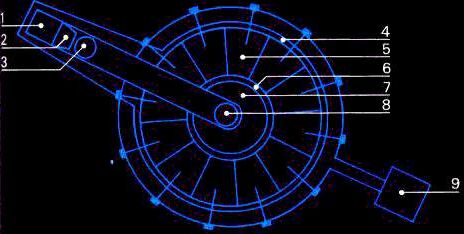Time Travel Research Center © 2005 Cetin BAL - GSM:+90 05366063183 - Turkey/Denizli
A 'Complex' Atom or
Fision Bomb MechanismA subcritical mass of U-235 or Plutonium is surrounded by high explosive in a Tamper (Neutron reflecting) casing.On detonation, the Neutron source is shot into position in the U-235 or Plutonium to initiate Fision, and the high explosive detonates, so compressing the U-235 or Plutonium into a supercritical mass that then undergoes rapid explosive Fision.

a Detonating system b Tamper casing c High explosive wedges d Explosive charge e Tamper wedge f Neutron source g Subcritical mass h Neutron source in position i Compressed supercritical mass |
A 'Simple' Atom or
Fision Bomb MechanismLittle Boy:
The 2OKT U-235 Bomb dropped on Hiroshima in WW2 was the simple gun type Bomb.
Before the reaction necessary for an explosion can take place, a certain amount of the radioactive material Uranium 235 must be collected in a certain volume known as the critical mass. A piece if U 235 slightly below critical mass is separated from a smaller piece. On detonation an explosive charge forces the smaller piece into the larger one, causing them to explode. It is certainly not beyond the realms of the imagination that such a Device could be easily built by a sophisticated, modern Terrorist Organization!
 |
|
Thermo-Nuclear Warhead or H-Bomb
A lithium Deuteride core (containing Lithium and Deuterium) is surrounded by U-235 or Plutonium, which in turn is surrounded by another relatively inert form of uranium U-238.The Fision reaction is set off as explained above. The heat generated causes the Deuterium and Tritium to undergo Fusion, high-energy Neutrons thus released cause the U-238 to undergo Fision. This is known as a Fision-Fusion-Fision Bomb.
1 Explosive charge 2 Tamper wedge 3 Neutron source 4 Neutron reflecting Tamper 5 High explosive 6 U-238 7 U-235 or Plutonium 8 Deuterium Tritium 9 Detonating charge A Fusion or 'Thermo-Nuclear' Device
a.k.a. H-BombUnlike the Atom Bomb, which works by Fision or the splitting of Atoms, the 'Hydrogen' or 'Thermo-Nuclear' Bomb works by the Fusion of Atoms, made possible by the heat generated in a Fision explosion.
Deuterium Fusion
1 In the heat of a Fision explosion, two Deuterium Atoms collide.
2 These Atoms fuze into the heavier Atom of Helium-3 releasing energy and one Neutron
Deuterium-Tritium Fusion
a A Deuterium and a Tritium Atom collide.
b They fuze into a Helium-4 Atom and release energy and one Neutron
c Although the creation of Helium-3 and Helium-4 releases less energy than Fision reactions, the Atoms are much smaller and therefore Thermo-Nuclear fuels will give three to four times the energy of the same mass of Fissile material and release up to six times as many Neutrons. The materials are also relatively cheaper and more abundant than Fissile material and are not subject to the dangers of critical mass.Hiçbir yazı/ resim izinsiz olarak kullanılamaz!! Telif hakları uyarınca bu bir suçtur..! Tüm hakları Çetin BAL' a aittir. Kaynak gösterilmek şartıyla siteden alıntı yapılabilir.
The Time Machine Project © 2005 Cetin BAL - GSM:+90 05366063183 -Turkiye/Denizli
Ana Sayfa /index /Roket bilimi /
E-Mail /CetinBAL/Quantum Teleportation-2
Time Travel Technology /Ziyaretçi Defteri /UFO Technology/Duyuru
